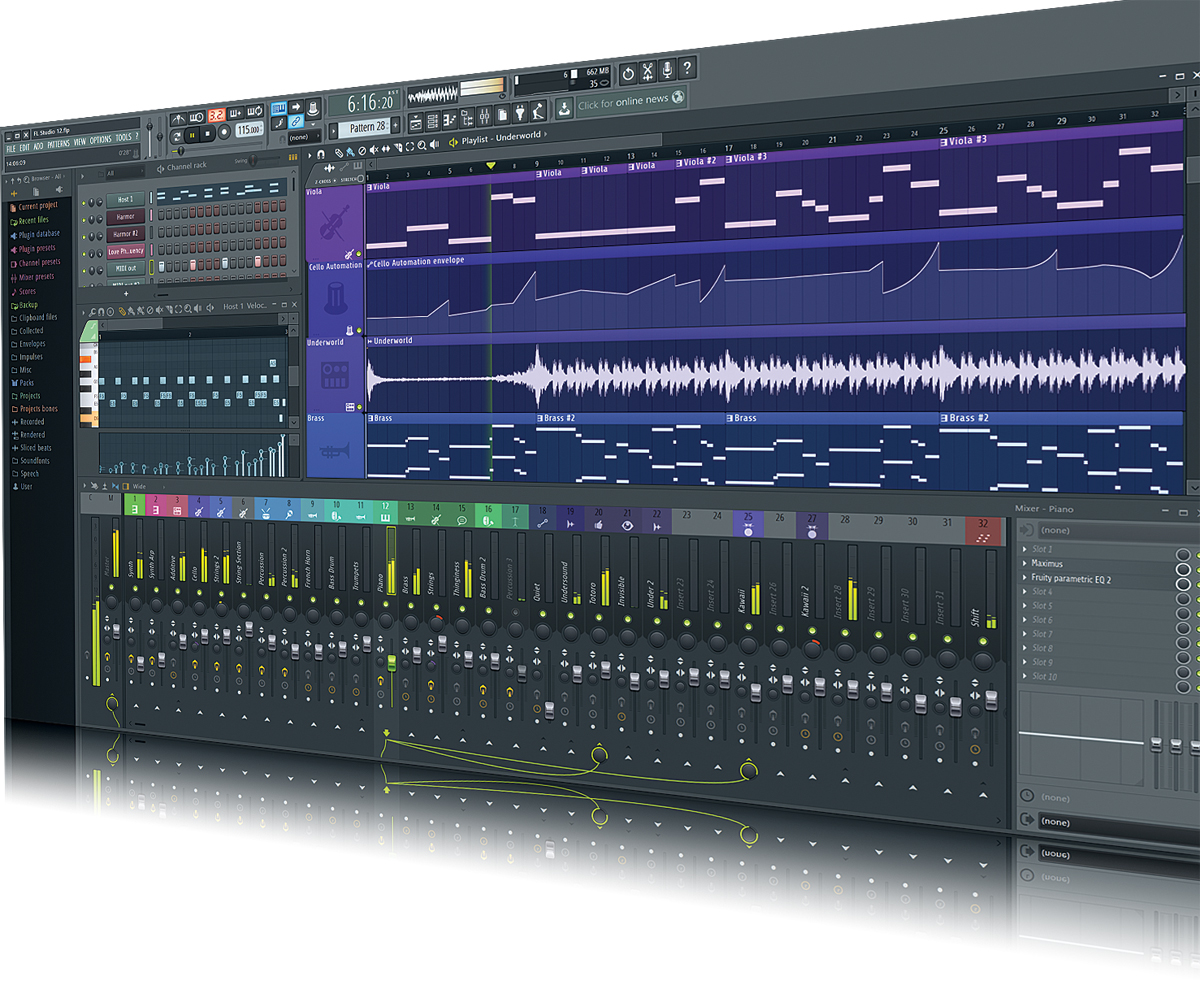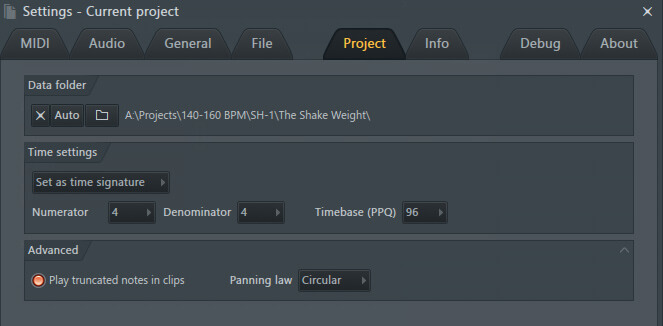- Audible artifacts in FL Studio These are usually caused by ' buffer underruns '. That is, the audio stream to the soundcard is interrupted when a temporary memory-buffer holding the audio data runs dry. This is caused by CPU and or Hard Disk overloading.
- If your CPU or disk usage climbs too high you will hear clicks or pops in the audio (buffer underruns). The good news is, CPU and disk usage can usually be lowered considerably if you take the time to make some adjustments to the FL Studio Audio settings. Why does this happen?
1. CPU Bar Graph - The CPU Meter shows the approximate percentage of CPU capacity used by the audio generation/mixing processes while playing the current project. This meter does not take into account any Graphical User Interface overhead from either FL Studio or plugins. For a more complete estimate of processor load, use the Windows Task Manager (press Ctrl+Alt+Del and select the Performance tab). To increase the refresh rate, right-click the view to open an options menu. For tips on reducing CPU usage see the Troubleshooting section.
2. RAM Usage Meter - The RAM meter shows how much of the 2 GB to 4 GB (2000 to 4000, depending on settings) address space allocated to FL Studio remains unused or used (right-click the panel to change mode between 'Show available' & 'Show used'). If you run out of address space you will experience memory errors such as access violations or buffer overflows.

RAM vs Address space - The amount of 'RAM' you have installed in your PC and the amount of working 'Memory address space' a program running on it has, are unrelated. Forget how much physical RAM your PC has. All 32-bit programs can access a maximum of 3 GB or 4 GB 'working memory' (see 'Increasing FL Studio working memory allocation' below). Each program is given its own 2 GB to 4 GB of address space, depending on system settings. These memory addresses are simply locations where the program can save and retrieve data as it performs real-time calculations and operations. If there are 4 programs running, there may be 12 GB of working address space allocated between them. These programs don't know or care how much RAM your PC has, or where these addresses point, they could be to data in RAM or data on the Hard Disk.

The best way to ensure this is to install FL Studio for your personal account (not 'All users'). So yes, multiple installations are OK, where you are the only user. This option is not applicable to companies, organizations or schools, they need to purchase a multiple license version. If your CPU load climbs too high, you will hear clicks, pops or stuttering in the live audio. This is known as a buffer underrun. The good news is, CPU load be lowered if you take the time to make some adjustments to FL Studio as shown below. Why do underruns happen? Make a Windows Desktop shortcut to the extended memory FL Studio executable '. Program Files (x86) Image-Line FL Studio FL (extended memory).exe' and use that to start FL Studio in future. CPU Meter Graph - Shows the CPU usage as a running graph, so that you can track changes and observe spikes.
FL Studio 20 works on Windows 7/8/10 (32-bit or 64-bit versions) or on macOS 10.13. FL Studio requires a 2 GHz AMD or Intel Pentium 3 CPU with full SSE1 support. It requires 2 GB of free disk space and 4 GB of RAM is recommended. The website states that 'the more powerful your CPU, the more instruments and FX you can run.' FL Studio is one of the best music software solutions that can be used as a Digital Audio Workstation (DAW). It provides you with the ability to create your own music as well as edit other music files. But sometimes people can be heard complaining about FL Studio’s performance issues. Most of the complaints are centered around the ‘extra.
If there is not enough physical RAM to accommodate all these working memory allocations, the Windows Operating System (OS) shares the RAM among the active programs and makes up for any shortfall with a special file on the hard drive acting as an extension to the RAM. In this way, the working memory addresses any program may point to your physical RAM (winner!), the hard-drive Page File (looser) or a combination of the two. It should be clear that the more physical RAM you have, the more likely it is that a program will win the RAM allocation 'lottery' and have all its working data stored there. As physical RAM is much faster than the hard-drive, programs run faster. For FL Studio, having lots of physical RAM means you are less likely to experience buffer underruns associated with accessing the data from disk, but what it does not fix is 'out of memory errors'.

Having more than 4 GB of RAM installed on your computer does nothing to break the 4 GB per-program limit associated with 32 bit applications, and that is what the RAM meter shows (depending on settings it will maximum at 2000, 3000 or 4000). Even if you have only 1 or 2 GB of RAM you can still use the extension options below to increase FL Studio's working memory allocation. This can be useful when working with very large audio files that won't load with the standard memory allocation.
Fl Studio Cpu Lag
Increasing FL Studio working memory allocation - There is an 'FL (extended memory).exe' file in the FL Studio installation directory. Using this to start FL Studio after making the following changes to your Windows operating system will give FL Studio access to 3 GB or 4 GB (up from 2 GB) depending on your OS:
* Windows XP 32 bit - Use the 3 GB switch in XP to access 3 GB of RAM.
+ 1. WARNING: Don't attempt the following unless you are confident working with Windows system files. Edit the Boot.ini file. The Boot.ini is an essential system file so we strongly recommend saving a copy of the 'Boot.ini' file as 'Original-Boot.ini' prior to mucking about with it. Add a '/3GB' switch command to the end of the boot-script in the 'Boot.ini' file and save.
+ 2. Restart the computer.
+ 3. Make a Windows Desktop shortcut to the extended memory FL Studio executable '..Program FilesImage-LineFL StudioFL (extended memory).exe' and use that to start FL Studio in future.
* Windows Vista 32 bit - Use the 3 GB switch in Vista to access 3 GB of RAM.
o Enable the 3 GB switch:
+ 1. From Windows Start browse to Programs > Accessories and right-click the Command Prompt file. Click 'Run as Administrator'.
+ 2. In the Command prompt window, type bcdedit /set IncreaseUserVa 3072 and press enter on your keyboard. Allow the change to be made when security windows appear.
+ 3. Restart the computer.
+ 4. Make a Windows Desktop shortcut to the extended memory FL Studio executable '..Program FilesImage-LineFL StudioFL (extended memory).exe' and use that to start FL Studio in future.
o Disable the 3 GB switch:
+ 1. From Windows Start browse to Programs > Accessories and right-click the Command Prompt file. Click 'Run as Administrator'.
+ 2. In the Command prompt window, enter bcdedit /deletevalue IncreaseUserVa and press enter on your keyboard. Allow the change to be made when security windows appear.
+ 3. Restart the computer.
+ 4. Remember to use the original FL Studio executable '..Program FilesImage-LineFL StudioFL.exe' in future.
* Vista & Windows 7, 64bit: FL Studio will automatically have access to 4 GB of RAM when the '..Program Files (x86)Image-LineFL StudioFL (extended memory).exe' is used to start FL Studio.
+ 1. Make a Windows Desktop shortcut to the extended memory FL Studio executable '..Program Files (x86)Image-LineFL StudioFL (extended memory).exe' and use that to start FL Studio in future.
3. CPU Meter Graph - Shows the CPU usage as a running graph, so that you can track changes and observe spikes.
4. Polyphony - Shows number of voices (independent sounds) being mixed at the same time. NOTE: that TS404 channels are not counted when displaying the polyphony.